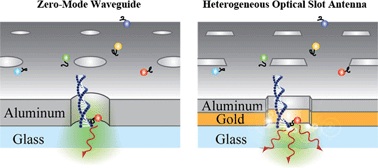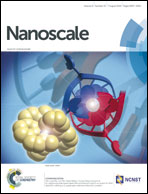Single-molecule detection and radiation control in solutions at high concentrations via a heterogeneous optical slot antenna†
Abstract
We designed a heterogeneous optical slot antenna (OSA) that is capable of detecting single molecules in solutions at high concentrations, where most biological processes occur. A heterogeneous OSA consists of a rectangular nanoslot fabricated on heterogeneous metallic films formed by sequential deposition of gold and aluminum on a glass substrate. The rectangular nanoslot gives rise to large field and fluorescence enhancement for single molecules. The near-field intensity inside a heterogeneous OSA is 170 times larger than that inside an aluminum zero-mode waveguide (ZMW), and the fluorescence emission rate of a molecule inside the heterogeneous OSA is about 70 times higher than that of the molecule in free space. Our proposed heterogeneous optical antenna enables excellent balance between performance and cost. The design takes into account the practical experimental conditions so that the parameters chosen in the simulation are well within the reach of current nano-fabrication technologies. Our results can be used as a direct guidance for designing high-performance, low-cost plasmonic nanodevices for the study of bio-molecule and enzyme dynamics at the single-molecule level.


 Please wait while we load your content...
Please wait while we load your content...